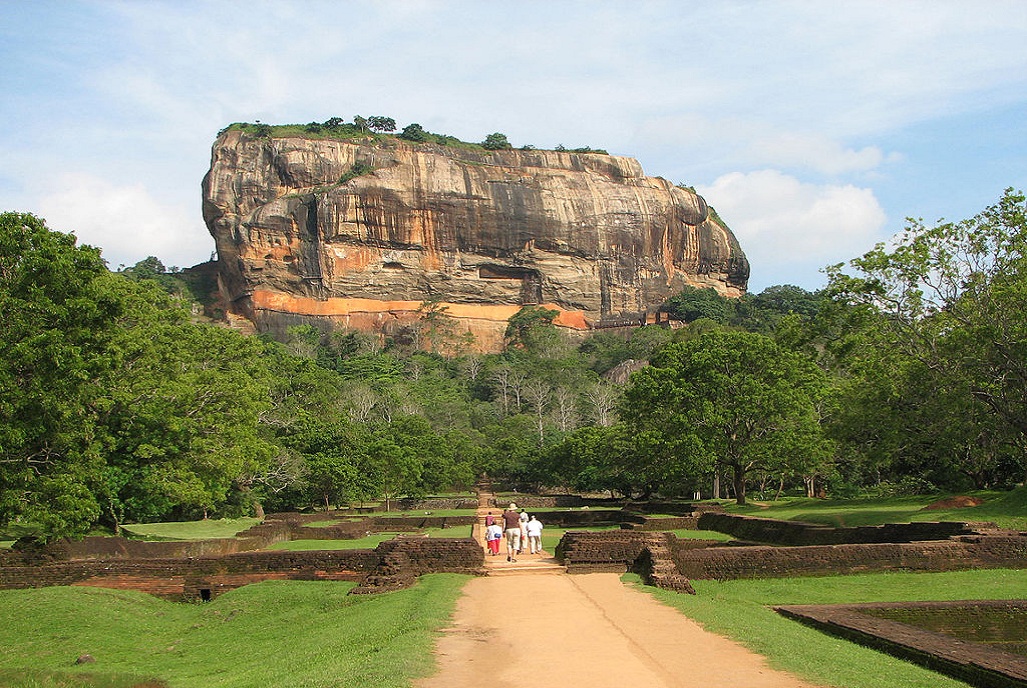1. Ancient City of Sigiriya (1982)
Also known as “The Lions Rock”, Sigiriya is an ancient rock fortress constructed in the 5th century by King Kasyapa. The entrance of the palace is built in the form of an enormous lion, which gives the site its name – Lion’s Rock.
Highlights: colorful frescoes decorate the rock, a mirror wall engraved with verses as old as the 8th century and some of the oldest landscaped gardens in the world.
Tip: Climb the Sigirya Rock and enjoy the view of Sri Lanka’s cultural triangle from the top.
2. Sacred City of Anuradhapura (1982)
Anuradhapura is where ancient civilization began in Sri Lanka and is the hub for Buddhism. Several well preserved ruins of monasteries, monuments and other ancient places are explored by tourists.
Highlights: 2000 year old holy Bo Tree under which Lord Buddha attained enlightenment and also, Anuradhapura has discovered most number of Buddha’s relics according to historical records.
Tip: The ruins are quite scattered so if you are on a quick tour, do your research and select a few sites you want to visit.
3. Ancient City of Polonnaruwa (1982)
After Anuradhapura, Polonnaruwa is the second most ancient Kingdom in Sri Lanka. The city is known as an expertly planned archaeological relic site.
Highlight: fabulous art, amazing medieval architecture, fantastic irrigation facilities, green environment, Brahmanic monuments, monumental ruins of the garden city constructed in the 12th century.
Tip: A bike will help cover all the sites faster with less walking required.
4. Sacred City of Kandy (1988)
Also known as Sri Lanka’s cultural capital, Kandy is home to the Temple of the Sacred Tooth Relic which is visited by Buddhists worldwide and other tourists too.
Highlights: Temple of the Tooth, Esala Perahera (Procession) held in July/August as an annual ritual of the Temple, Kandyan cultural dance, natural beauty such as forested hills and tea plantations.
5. Southern city of Galle and its Fortifications (1988)
Galle is a popular city and port on the southern coast. Initially built by Europeans, there is plenty of evidence to show the interaction of European architecture and South Asian traditions.
Highlights: Dutch Fort, Dutch and British colonial architecture, Dutch Reformed Church and the National Maritime Museum are popular landmarks in the fort area.
Tip: Get on top of the fortress walls at dusk for an unmatchable view of the sunset on one side and the old town on the other.
6. Sinharaja Forest Reserve (1988)
A popular national park in Sri Lanka is the Sinharaja Forest Reserve, translated to “Kingdom of the Lion” in Sinhalese. This was declared a Biosphere Reserve as it plays a major role in the country’s ecosystem.
At Sinharaja you will find several rare endemic species of birds, mammals, amphibians, butterflies, fish and reptiles.
Tip: Drier months (August, September, and January to April) are preferable for visiting Sinharaja and making animals slightly easier to spot.
7. Golden Temple of Dambulla (1991)
The Cave Temple in Dambulla is the largest and best preserved rock cave temple in Sri Lanka with a height of 600 feet and includes 5 caves and 157 statues of Lord Buddha, all dating back to the 1st century BC.
Highlights: Delicate and intricate paintings decorating the caves and temple walls.
Tip: Remove footwear before entering the complex and keep your socks on to avoid pain from the rocks.
8. Central Highlands of Sri Lanka (2010)
The UNESCO nominated central highlands of Sri Lanka consist of three wet-zone parks:
- Horton Plains National Park
- Knuckles Conservation Forest
- Peak Wilderness Protected Area
Highlights: Adam’s Peak which is the highest point, giving you an amazing view, and is also a popular center for Buddhist pilgrims. Also look out for endemic and endangered species such as purple-faced langur and the Sri Lankan leopard at the Horton Plains and Knuckles Range.
Tip: January to April is the best time to visit and enjoy the cool and dry climate.

